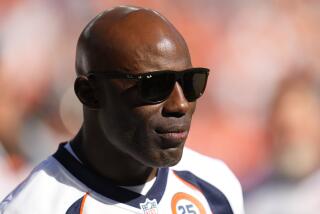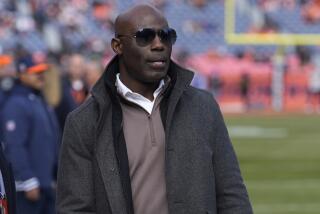Chill Wind Over Witnesses
- Share via
From the way Steve Cooley’s G-men treated him, you might think that Mitchell Crooks was a drug kingpin or Mafia don rather than an unemployed party disc jockey with some lapses in his past. The district attorney’s decision last week to deploy a squad of agents--which cuffed him with TV news cameras rolling and carted him away on years-old warrants--looks too much like intimidation of future witnesses in police brutality cases.
Crooks was at a motel across from the gas station as police officers were questioning Coby Chavis Jr. on July 6 about expired tags on his car’s license plate. When Crooks heard screams, he grabbed his video camera. What he saw--and what the rest of the world has now seen--was an Inglewood officer slamming a handcuffed Donovan Jackson, Chavis’ son, face-down against a police car.
For the record:
12:00 a.m. Aug. 3, 2002 For The Record
Los Angeles Times Saturday August 03, 2002 Home Edition California Part B Page 20 Editorial Pages Desk 0 inches; 34 words Type of Material: Correction
Mitchell Crooks--An editorial July 16 should have said the arrest of Crooks, who videotaped a police incident in Inglewood, was captured on a Cable News Network security camera, not TV news cameras.
For his public service, Crooks has gotten 15 minutes of fame and an armed escort to the Placer County jail. And what of Jeremy Morse, the officer seen smashing 16-year-old Jackson on the car and then punching him? He’s home on paid suspension while a grand jury and a slew of government agencies investigate the incident. Something’s askew here.
Crooks had outstanding warrants for petty theft and a 5-year-old hit-and-run accident in Northern California. After L.A. investigators learned of those warrants, they swooped down on Crooks as he left a CNN studio and stuffed him into a plane bound for Placer County, where the warrants had been issued. They knew full well that news cameras would tape the bust.
The district attorney’s office says it asked Crooks to testify before the grand jury about what he saw and wanted him to turn over his videotape so it could be authenticated. But according to Cooley’s office, the 27-year-old was evasive, spoke of warrants he needed to “clear up” first and then hung up on investigators, raising their suspicions. At that point, Cooley’s office said, it ran his record.
So far, no problem. But why orchestrate a four-alarm arrest?
Cooley seems to be showing a taste for the footlights and the big show. In May, his agents briefly shut down the tiny Metropolitan News-Enterprise legal newspaper, throwing reporters and editors out on the street while they looked for a document that the publisher said he had already agreed to turn over. We’d bet Cooley would never try this stunt at the Los Angeles Times or another large paper. As with Crooks, he picked a vulnerable target and sought maximum publicity.
Cooley’s intent in the Crooks case may not have been to intimidate witnesses to police misconduct, many of whom may have less-than-spotless records, but the chill from Crooks’ arrest was unmistakable.
More to Read
Sign up for Essential California
The most important California stories and recommendations in your inbox every morning.
You may occasionally receive promotional content from the Los Angeles Times.













